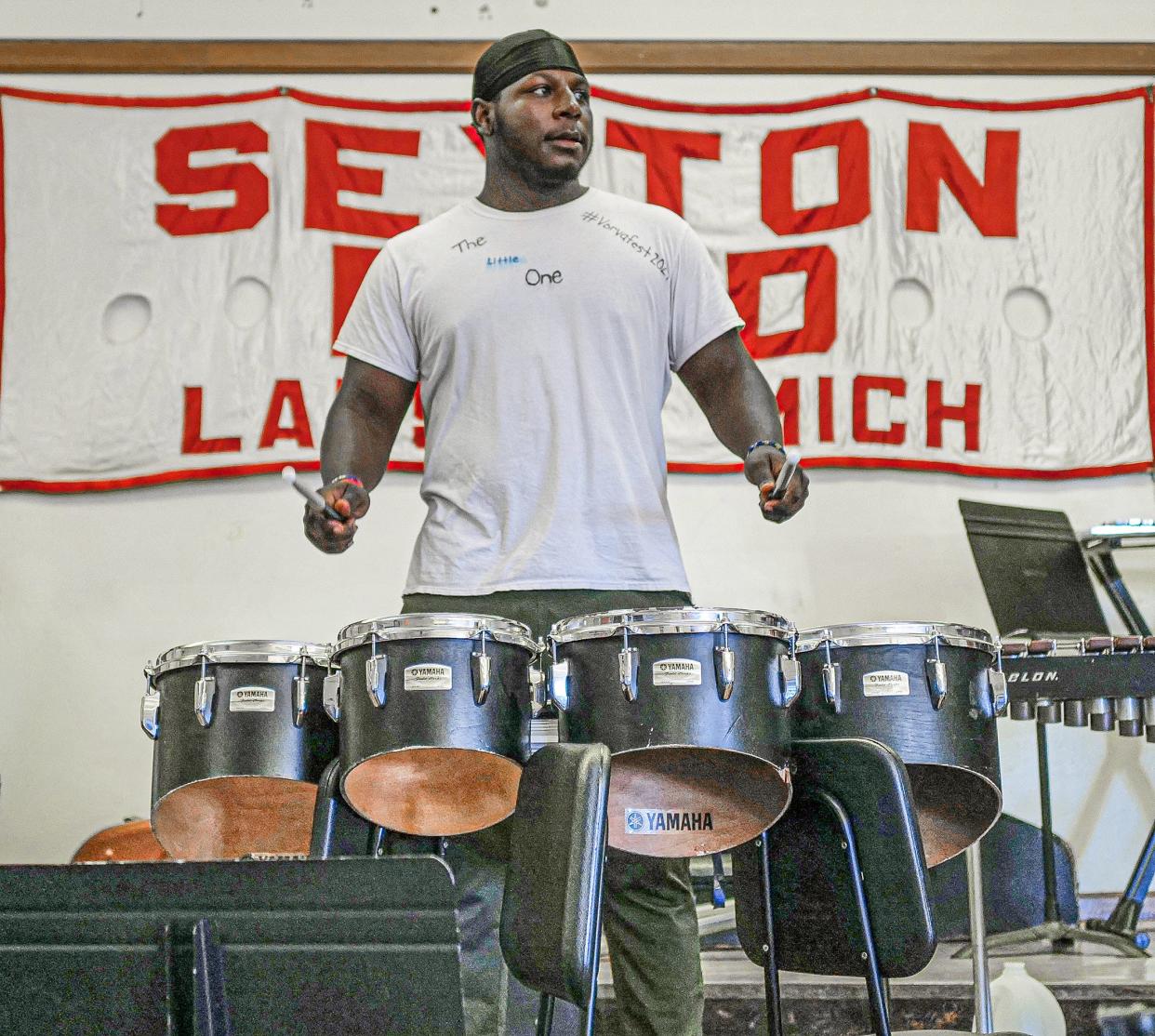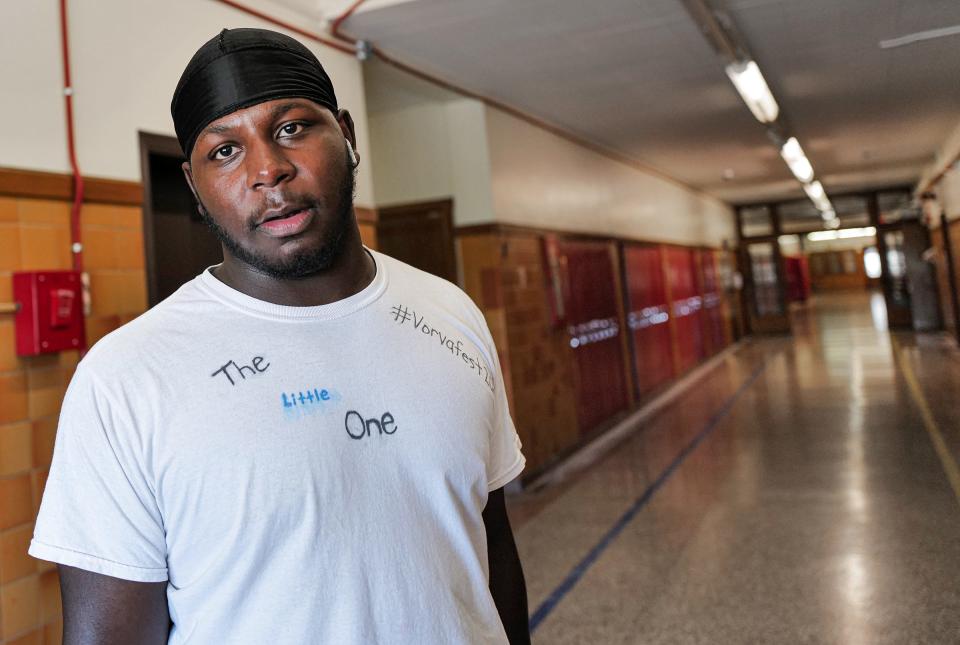With high school behind them, some local graduates are ready to go to work

LANSING — When a home goes up in flames and firefighters rush to put out the blaze or rescue people trapped inside many try to get away from the fire.
But for teenager Dayveon Thomas, heading toward the fire is a calling, and a career.
Thomas is part of Sexton High School's graduating class of 2022 and a recent graduate of the Lansing Fire Science Academy, a local program that trains high school students in Lansing to be firefighters and EMTs.
So while some of his classmates are enjoying their summer before starting their college education this fall, Thomas is eager to start his career as a firefighter.
“The thought of running into a burning building to save somebody else or to be there for families on their worst day, taking some of their stress down,” Thomas said. “(It's about) helping people out.”

Thomas is among growing numbers of high school graduates across the country opting to enter the workforce as quickly as they can after graduation rather than enrolling in a college or university degree program. Total post-secondary enrollment fell by 16.2 million students this spring, according to the National Student Clearinghouse Research Center resulting in a 4.1% decline over the past year. Undergraduate enrollment saw the steepest decline, dropping 4.7%.
For graduates like Thomas, the choice to skip or at least delay going to college for the near future was an easy decision. He’s been enamored with the firefighting profession, thanks in part to his uncle, who is a firefighter in Bangor.
“Just watching him do what he does, the way he carries himself,” Thomas said. “I’ve been fascinated.”
Thomas still has to earn his firefighting and EMT certifications, but that doesn't require a college degree. With the help and support of firefighters from the Lansing Fire Science Academy, he hopes to earn his certification at Lansing Community College and get to work. They’ve expressed hope he’ll stay and work in Lansing.
Students see local work opportunities
A record 890 students are already enrolled at the Ingham Intermediate School District’s Wilson Talent Center for classes next fall and many will receive opportunities to enter the working world as soon as they earn their high school diplomas.
Wilson Talent Center offers career and technical education courses for juniors and seniors attending high schools within the Ingham ISD’s service area encompassing 12 public school districts, 10 public school academies, as well as more than 44,000 students spread across seven mid-Michigan counties.
More than 18 programs are offered in 12 career clusters. Some of the more popular programs include health care, cosmetology, automotive technology and welding technology. Some students work externships and internships and, if they go well, can start working immediately after graduation.
In other programs, like hairstyling, students are trained and once they graduate, they can take a test, earn certification and can go right to work.
“A lot of students will go to college,” said Joe Wenzel, Wilson Talent Center principal. “But they have the opportunity of working in college, continuing their education or going right into the workforce.”
As students prepare for future careers, they realize the loads of debt they could take on pursuing a college degree.
More than 40 million Americans collectively accumulated more than $1 trillion in student loan debt and, in Michigan, student borrowers owe an average of $36,116, according to the Education Data Initiative.
The burdens of student loan debt have led some students to reconsider their futures after high school.
“I think students understand that college debt is a real thing,” Wenzel said. “I think it’s talked about more commonly in our culture now. They realize it’s there and there are opportunities for them to get good-paying jobs in careers they enjoy without all the college debt.”
Students may still have to pay for their certification courses, but other programs help pay for that, like the Lansing Promise. Thomas, and any graduate of a Lansing high school, is included in the scholarship program that covers tuition and fees to take up to 65 credits at Lansing Community College or the equivalent dollar amount toward tuition and fees at Michigan State University, Olivet College and, most recently, Davenport University.
Building a talent pipeline
LCC offers numerous certification programs, including in popular fields like welding and advanced manufacturing. In recent years, more and more recent high school graduates have been coming through LCC to get their certification and get to work.
“There’s a different feeling right now,” said Cathy Wilhm, LCC’s dean of technical careers. “Employers are looking at our 18-year-olds or high school students differently than in the past.”
With ongoing workforce shortages, employers are looking at different ways to bring on more talent, including recent attempts to start talent pathways to bring younger employees, like recent high school graduates, into their workforces.
Many of the certifications required to work in fields needing people, like welding and automotive, don’t require associate or bachelor’s degrees. Instead, students can take certificate programs over one to two semesters and get to work shortly after.
LCC works to bring employers in to recruit students, offering freshly graduated high school students a job and labor for short-staffed employers.
“In the past, you had more people than you really needed. The younger people … they didn’t see them as being ready,” Wilhm said. “Now they need to build their talent pipeline and they see an opportunity to take younger people with an interest or propensity for something and help develop that talent.”
There are real career opportunities more students are picking up on. From fall 2020 to fall 2021, technical careers programs at LCC added 100 more students to its enrollment.
“It’s busting at the seams right now,” Wilhm said. “There is a renewed interest.”
While Thomas has to wait a little bit before he can begin pursuing his career in firefighting, in the meantime he’s applied for a job with GM and is looking for opportunities to stay involved with the fire department, including a ride-along he hopes to htake part in.
He’s only in the early stages of pursuing his career, but Thomas is already excited to think about the possibilities.
“I like to have as many options as I can whether it’s work or a career,” he said. “I want to have endless options and do as much as I can.”
Contact Mark Johnson at (517) 377-1026 or majohnson2@lsj.com. Follow him on Twitter at @ByMarkJohnson.
This article originally appeared on Lansing State Journal: Lansing-area graduates entering workforce, bypassing college

